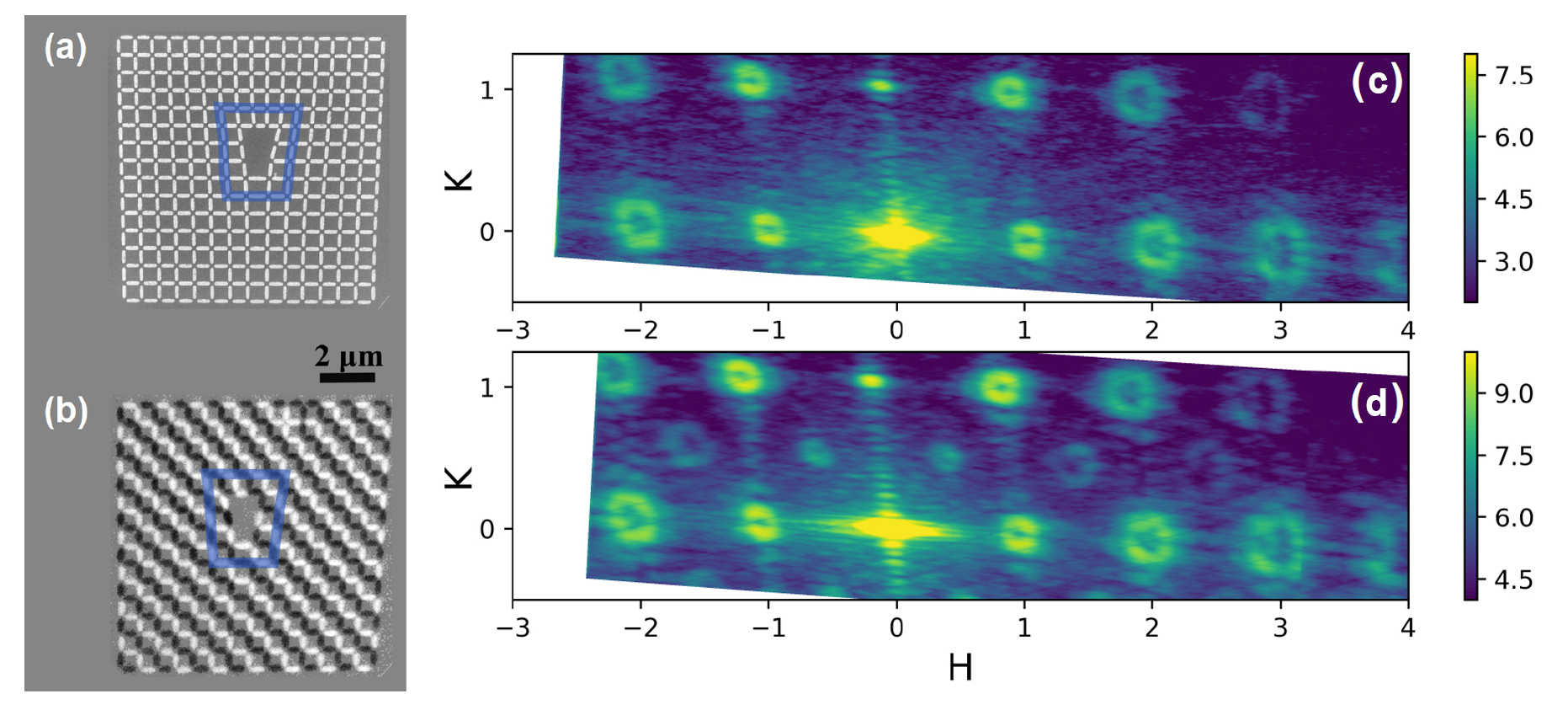SCIENTIFIC ACHIEVEMENT
Advanced Light Source (ALS) studies helped scientists understand how a nanoscale magnetic lattice (an artificial spin ice) acts as a toggle switch for x-ray beams with spiral character.
SIGNIFICANCE AND IMPACT
The findings represent an important step toward the development of a versatile new tool for probing or controlling exotic phenomena in electronic and magnetic systems.

A curious singularity
Artificial spin ices (ASIs) are engineered arrays of nanomagnets that are often “frustrated,” meaning that the magnets, constrained by geometry, cannot align themselves to minimize their interaction energy. Water ice exhibits a similar property with regard to the positioning of hydrogen atoms.
While studying ASIs, a collaboration between scientists from the University of Kentucky and the ALS (see related feature article) made an interesting observation: light scattered from certain ASIs produced diffraction patterns in which spots of constructive interference were shaped like donuts instead of dots. The donuts were indicative of a phase singularity—a hallmark of light with a property known as orbital angular momentum (OAM).
Imparting a twist to x-rays
In the visible-light regime, OAM has a wide range of applications, including quantum cryptography, optical tweezers, and telecommunications. While OAM in x-ray light is much less common, it holds great promise for imaging and probing, for example, topological spin textures in magnetic systems, polar vortices in ferroelectrics, and chiral systems and nanostructures.
However, x-rays with OAM are more difficult to generate, and previous efforts using gratings with a particular type of defect (forked dislocations) produced only static beams. ASIs, whose properties can be tuned based on geometry and competing interactions, often exhibit different ordered phases in response to temperature and external magnetic fields. Thus, the researchers hypothesized that square-patterned ASIs with forked defects might be able to generate OAM beams that could be switched on and off at will.
A square-grid ASI was constructed from nanomagnets of permalloy (a nickel–iron alloy) on a silicon substrate. The grid included a defect caused by adding two extra rows of squares in the middle of the grid—a double edge dislocation. This defect had the potential to generate OAM through scattering from either the structural lattice (i.e., the charge order) or the magnetic lattice (an antiferromagnetically ordered ground state), with the latter being responsive to changes in temperature and external magnetic field.
ASI imaging and OAM generation
ASI images with magnetic contrast were recorded using photoemission electron microscopy (PEEM) at ALS Beamline 11.0.1.1. Resonant magnetic x-ray scattering with coherent x-rays was conducted at ALS Beamline 7.0.1.1 (COSMIC Scattering) and at the National Synchrotron Light Source II (NSLS-II).
The ability to switch between circular polarizations at Beamline 11.0.1.1 was critical to confirming that the ASI was in an antiferromagnetic ground state below the phase transition temperature before doing the scattering experiments at COSMIC. It also established that the sample was ordered into a single antiferromagnetic domain. COSMIC’s coherent x-rays allowed for the generation of OAM beams from the ASI and the observation of diffracted x-rays from structural and magnetic lattices.
Overall, the work demonstrated that a magnetic lattice with the double edge defect does indeed have the ability to impart OAM to a diffracted x-ray beam, and that the OAM could be switched on and off with modest variations in temperature or an applied magnetic field. The findings represent an important step toward realizing reconfigurable optics for the generation and analysis of soft x-ray OAM, potentially opening up exciting new ways to investigate matter.

Contacts: Todd Hastings and Justin Woods
Researchers: J.S. Woods (Univ. of Kentucky and Argonne National Laboratory); X.M. Chen (Berkeley Lab and Univ. of Kentucky); R.V. Chopdekar, R. Koch, A. Scholl, S. Kevan, and S. Roy (ALS); B. Farmer, L.E. De Long, and J.T. Hastings (Univ. of Kentucky); C. Mazzoli, W. Hu, and S. Wilkins (Brookhaven National Laboratory); A.S. Tremsin (Univ. of California, Berkeley); and W.-K. Kwok (Argonne National Laboratory).
Funding: U.S. Department of Energy, Office of Science, Basic Energy Sciences program (DOE BES). Operation of the ALS is supported by DOE BES.
Publication: J.S. Woods, X.M. Chen, R.V. Chopdekar, B. Farmer, C. Mazzoli, R. Koch, A.S. Tremsin, W. Hu, A. Scholl, S. Kevan, S. Wilkins, W.-K. Kwok, L.E. De Long, S. Roy, and J.T. Hastings, “Switchable X-Ray Orbital Angular Momentum from an Artificial Spin Ice,” Phys. Rev. Lett. 126, 117201 (2021), doi:10.1103/PhysRevLett.126.117201.
ALS SCIENCE HIGHLIGHT #444